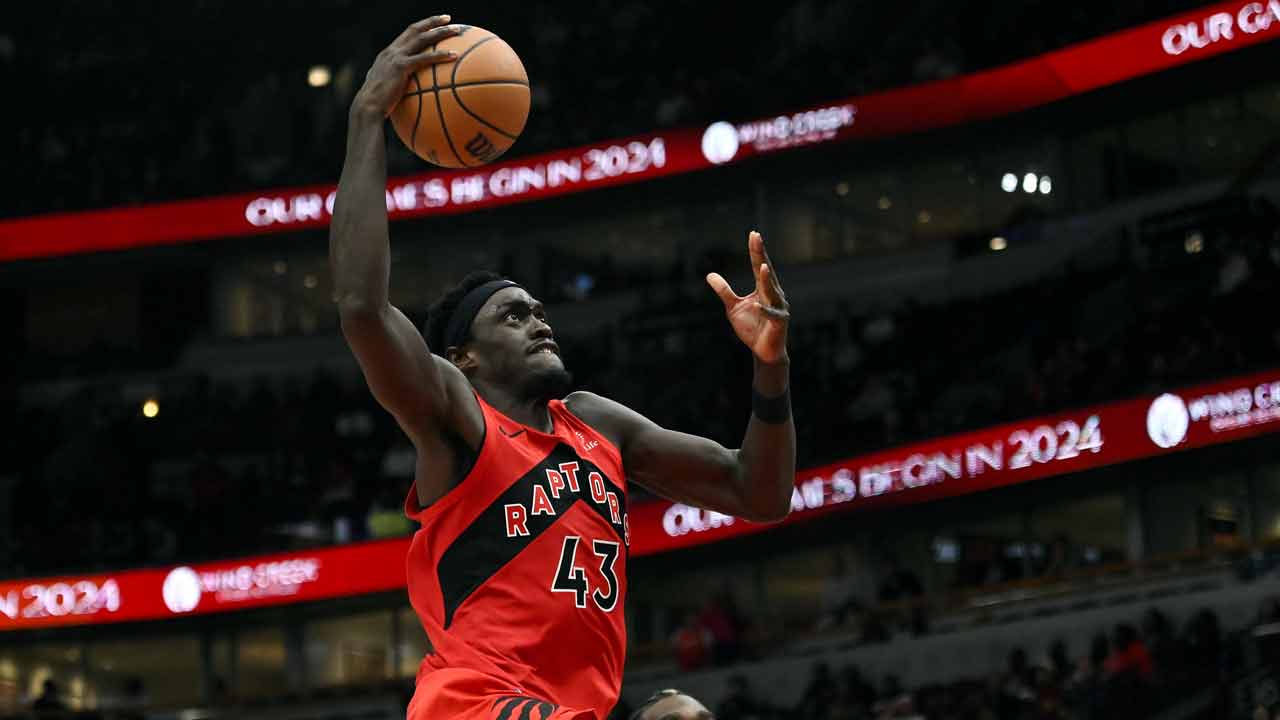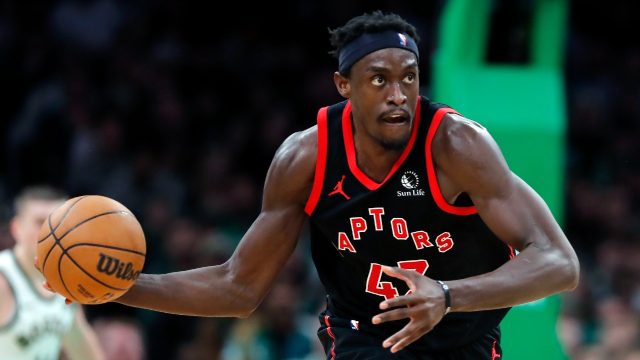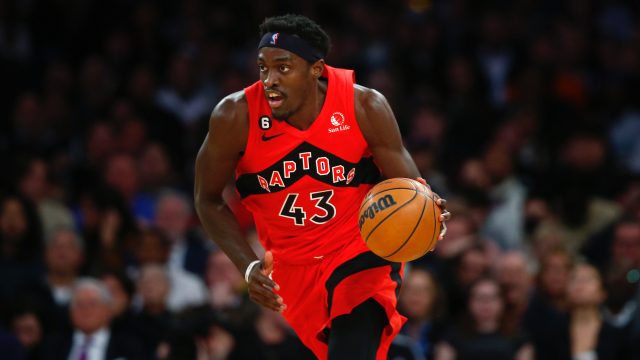
The Toronto Raptors acted early once again Wednesday, dramatically reshaping the future of their franchise by dealing Pascal Siakam to the Indiana Pacers for a package headlined by draft picks.
As always, any number of questions follow. This is a rare case where I’m not sure those answers will change your outlook on the trade, which was much more about timelines and player treatment and long-term franchise equity than about the raw in-versus-out of a deal; those who like it like it for the same reasons they’ve argued for it to happen for months, and those who don’t like it won’t be enamoured with an uninspiring, if mostly fair, return.
We still have to answer those questions, though, and this particular trade has a number of important salary cap and asset-related trickle-downs. So let’s sort through it.
The trade
To Indiana: Pascal Siakam, the worst of New Orleans’ or Chicago’s 2024 second-round pick
To New Orleans: Cash
To Toronto: Bruce Brown, Jordan Nwora, Kira Lewis Jr., Indiana’s 2024 first-round pick, the worst of Utah’s, Houston’s, Oklahoma City’s, or the Clippers’ 2024 first-round pick and Indiana’s 2026 top-four protected first-round pick
Cut: Christian Koloko (Raptors), James Johnson (Pacers)
The mechanics of the trade, and how Indy pulled this off
If you are a frequent user of a trade machine, the specifics of this trade may have looked incorrect to you. The Pacers are not sending out enough salary to take back Siakam’s contract. Under normal circumstances, anyway. Because the Pacers were operating below the salary cap, they were allowed to structure this three-team deal as two separate trades.
First, they acquired Kira Lewis Jr. from the Pelicans for $110,000. This served two purposes: Getting the Pelicans out of the luxury by unloading Lewis into Indiana’s available cap space. Second, it gave the Pacers an additional salary to make the cap math work. (They had to cut James Johnson to create the roster space, for which they surely received a ushiro geri.)
If Indiana wasn’t under the cap, it would have had to wait 60 days to include Lewis in a trade with other salaries. Here, we see the rare value of operating below the cap in-season.
Outgoing: Siakam, his Bird rights and next deal, and cutting Koloko
Siakam’s future was the single biggest pivot point the Raptors would face this year (or last year, or this off-season), and while the trade is close to cap-neutral for 2024-25, removing Siakam answers the biggest question the front office had to answer. No, Siakam is not a part of the future.
What they do with that certainty – and the potential cap space they could find their way to – will be the story of the summer for them.
For Indiana, acquiring Siakam without losing any of its interesting prospects is excellent work. Siakam projects as a near-perfect two-way fit on the court with the Pacers, and while he’s older than their star – Tyrese Haliburton isn’t much older than Scottie Barnes – the Pacers are loaded with young talent that can make that easier to manage.
In trading three firsts for him, Indiana has to be confident in re-signing Siakam this summer. Siakam can only sign a two-year extension with Indiana now, so he’s almost certainly headed to unrestricted free agency, but Indiana will hold his Bird rights and have a few months here to convince him it’s a good fit. I’ve always been skeptical about how much a player’s stated willingness to re-sign should actually matter to a team acquiring them, because fit, Bird rights – which allow you to exceed the cap to re-sign a player and offer him a longer deal with larger annual raises – and the ultimate contract amount usually end up mattering most. Siakam can only wink-wink agree to stay, if he’ll even do that, but Indiana should feel good about its chances to keep him long-term.
And yes, the Raptors could go after Siakam as a free agent if they carve out the cap space. There is no rule against that once Siakam is a free agent. It’s just unlikely, for reasons you can guess.
The Raptors also waived Christian Koloko. The trade rules require you to have enough roster spots before a trade is made, so the Raptors had to create space for the 3-for-1 deal.
Koloko is an unfortunate consequence of the roster crunch here. He has been out since early in the summer due to a respiratory issue, and while his activity level appeared to have picked up of late (from what little we’re privy to), he remained a fair distance from returning to play. The Raptors remain high on him as a prospect, and I wouldn’t be at all surprised to see him signed in the G League for Raptors 905 and/or re-signed by the Raptors in the off-season.
It’s a very unfortunate situation for Koloko and one the Raptors opted for over cutting a potentially valuable salary at the deadline in Thad Young or Otto Porter Jr. or a locker room presence like Garrett Temple.
For those who have asked, a disabled player exception does not grant you an extra roster spot, just cap relief, so there was no path like that to create a spot here despite Koloko’s situation.
Incoming: Are any of these players sticking around, and the new draft cache
The Raptors brought in three players on potentially expiring contracts, which helps keep them lean and agile this summer.
Brown has a $23-million team option for next year, which the Raptors could decline at no cost and reap the cap space instead. It’s also very possible the Raptors canvas the league to find another home for Brown by Feb. 8. Brown can’t be combined with other players in trade now, but he can be traded individually, and his $22-million cap hit for this year is large but not cumbersome enough to rule it out.
Nwora is on a $3-million expiring contract and is headed for unrestricted free agency. He’s shown the ability to shoot the ball at a decent clip in Milwaukee and Indiana, but he’s played sparingly this year and hasn’t shot well when given the opportunity. He’s likely here just to make the math work, though the Raptors will also get a look at him in bench minutes to see if he has any untapped upside.
Lewis does have untapped upside. A former lottery pick who never quite clicked in New Orleans, Lewis has operated as a “Quad-A” type player, way too good for the G League when sent down there but never quite delivering in the NBA. Even with a deeper guard rotation now, the Raptors should see what Lewis can offer. Realistically, he is making $5.72 million and is a pending restricted free agent with a qualifying offer that’s too large ($7.91 million) for the Raptors to tender, so he’ll be an unrestricted free agent in July. There’s still value in seeing if the 22-year-old can click, as you can always re-sign him to a new deal without RFA status.
The Raptors also picked up three first-round picks of varying interest. They will receive Indiana’s pick in 2024 (17th-to-19th if the season ended today), the worst of the first-round picks from Utah, Houston, OKC, or the Clippers (27th if the season ended today), and Indiana’s 2026 first-round pick, protected for picks Nos. 1-4 (which means the Raptors will get it if it lands Nos. 5-30; if it lands top-four, the pick would roll over to 2027).
Those are not terrific firsts. Picks are still picks, and they’re valuable as selections or as trade currency. They’re particularly helpful because the Raptors have been at a large pick deficit for years now, limiting their ability to restock the talent pipeline with inexpensive rotation pieces or high-upside lottery tickets. Now, you have to actually hit on those picks, and the late-20s will land you a Malachi Flynn far more often than a Siakam. But you can only hit on picks if you have them.
On the currency side, the Raptors now have some additional assets to trade for players or to move up in the draft if they’re targeting a specific player. Picks 19, 27 and 31 (the Detroit pick via New York from the OG Anunoby trade), theoretically, could let you move up into the later part of the lottery, or:
What happens with the pick the Raptors owe the Spurs?
The Raptors could get their own pick this year, too, giving them four top-32 picks in the 2024 draft. Realistically, the Raptors aren’t getting lower in the standings than sixth-to-last, which would give them an average pick of No. 5.5, a nine per cent chance at the No. 1 pick, and a 45.8 per cent chance at keeping their pick.
Again – finishing sixth-to-last gives them a bit less than a 50-50 chance at keeping their pick, even though it’s top-six protected. So even if you bottom out, you’re relying on ping-pong balls to keep your pick.
Whether that matters to you comes down to preference. A high pick is a high pick, and even in what’s considered a weaker draft, there will be very good players available. If the Raptors keep their pick this year, they owe the Spurs their 2025 first-round pick instead, once again top-six protected. Some may prefer to just convey the pick to the Spurs this year, get it over with, and have control of their pick in a deeper 2025 draft.
2023-24 Impact: Cap situation, luxury tax room, trade exception, future moves
The Raptors sent out $37.89 million in this trade and took back $30.72 million, giving them an additional $7.17 million in breathing room. They were already well above the cap, so there’s no impact there, but this gives them significant breathing room under the luxury tax now.
The Raptors were about $2 million below the tax before this deal, they’re now $4.84 million below it.
They’re even further below if we exclude some unlikely incentives that I’m including. Those incentives only count against the tax hit if they’re achieved. The Raptors have $4.35 million in unlikely incentives on their books, very little of which projects right now to be achieved.
The space under the tax gives the Raptors some wiggle room in subsequent trades, allowing them to take back more salary without worrying about the tax line. It also means that they could comfortably cut players to sign new ones, if they decided to go that route post-deadline with some of the players who aren’t in the long-term plans.
Brown, Nwora and Lewis can’t be aggregated with other players in trade by Feb. 8, by the way, but they can be dealt individually, and the Raptors have a number of other veterans who could have a market at the deadline. Whether via trade or cuts, the Raptors will have more flexibility now than they did before.
The Raptors also (probably) created a $10.17-million traded player exception in this deal, which they will have a year to use. That can’t be combined with other salaries or exceptions, but it could be helpful to absorb a player in trade making up to $10.27 million. (I say probably because the team has a few options for how to structure the trade, paperwork-wise. This is what I would do.)
Summer 2024 Impact: A cap-space team for the first time in years?
There is not necessarily a change to the Raptors’ 2024 off-season outlook here. The numbers are the same; the perspective has changed. The trade is effectively salary-neutral for 2024-25, as all of the players involved are (or can be) free agents.
The Raptors have seven players under contract for next year: RJ Barrett, Jakob Poeltl, Dennis Schroder, Chris Boucher, Barnes, Gradey Dick and Jalen McDaniels. (It’s entirely possible some of those names are moved, too.) They also have RFA rights on Quickley. The seven players on guaranteed contracts are set to earn $88.8 million.
The salary cap for next year is currently projected to be $142 million, with a luxury tax line of $172.5 million. Those estimates are a bit more conservative than they have been in the past, due to some uncertainty around TV-based revenue at the regional level. The cap could go as high as $149.6 million, which would mean a tax line of about $181.8 million. There’s some uncertainty there right now.
If the cap comes in at $142 million and the Raptors renounced all their rights to maximize cap space, except for Quickley’s, and declined Brown’s option, they could get to about $36 million in pure cap space.
They would lose their mid-level exception if they went that route, instead getting the smaller room exception, and they’d lose the ability to exceed the cap to re-sign someone like Trent. If all you cared about was cap space, though, $36 million is a good starting point, and you can create more if you can unload some of the other salaries still owed in 2024-25. (Quickley having a pretty small cap hold as a restricted free agent is very helpful here, allowing you to maximize cap space and then come back to re-sign him later.)
Not extending or re-signing Siakam also makes the longer-term future a little easier to manage, cap-wise. You have fewer good players now, but there’s a less obvious tax crunch ahead with the knowledge that Siakam won’t be on a max deal along with Quickley’s next contract and Barnes’ eventual max.
Takeaways
• The trade opens up a bit of breathing room beneath the tax for subsequent trades at the deadline, or for post-deadline cuts and signings.
• This is technically cap-neutral for 2024-25 since everyone involved can become a free agent. This is more about what it signals for the Raptors’ direction. They can find their way to about $36 million in cap space as currently constructed, and more if they make additional moves.
• Brown’s $23-million team option for 2024-25 is interesting, as it offers a path to more cap space or a reasonably priced rotation player with trade value. He can also be traded again before the deadline, he just can’t be aggregated with other players (he has to be dealt solo).
• The three picks the Raptors acquired will likely all be in the back half of the draft. It restocks the cupboard, there is just not a blue-chip piece in this trade. They went for quantity over quality, the opposite of their approach in the OG Anunoby deal.
• There is probably more to come, so we’ll save a full-scale 2024 off-season setup for then.







